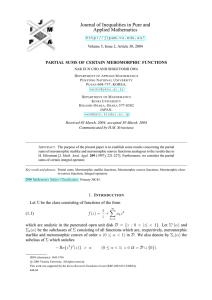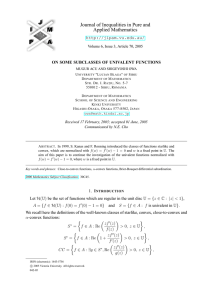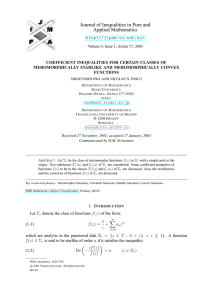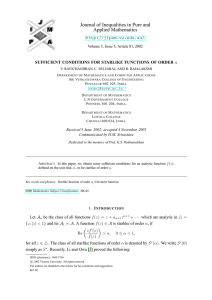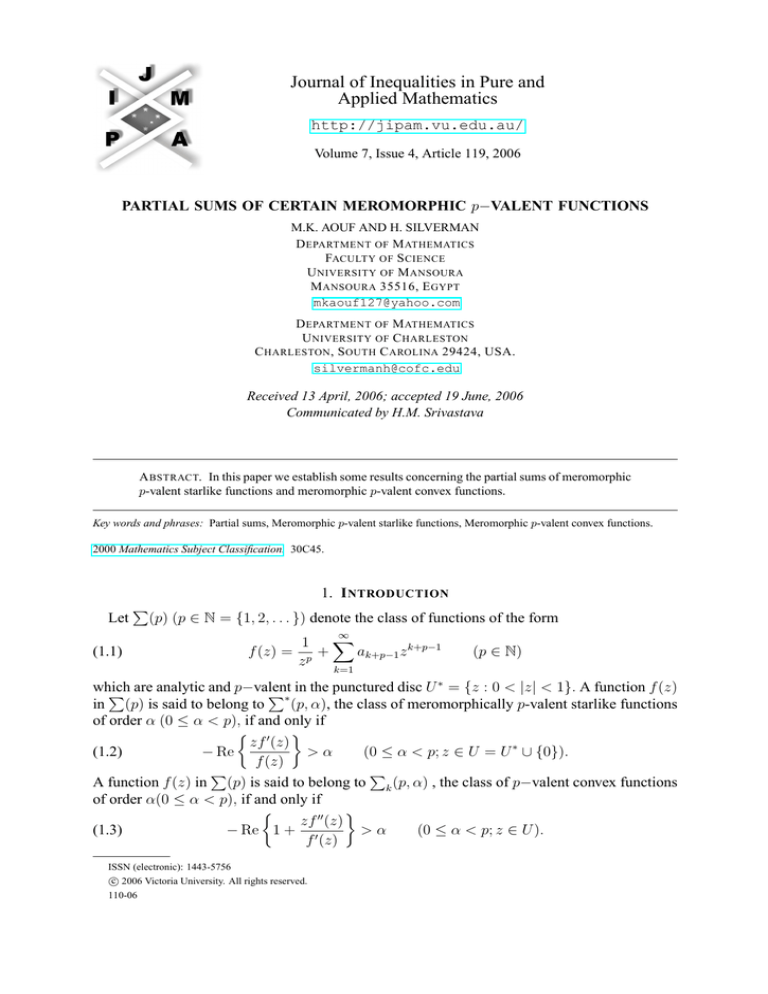
Journal of Inequalities in Pure and
Applied Mathematics
http://jipam.vu.edu.au/
Volume 7, Issue 4, Article 119, 2006
PARTIAL SUMS OF CERTAIN MEROMORPHIC p−VALENT FUNCTIONS
M.K. AOUF AND H. SILVERMAN
D EPARTMENT OF M ATHEMATICS
FACULTY OF S CIENCE
U NIVERSITY OF M ANSOURA
M ANSOURA 35516, E GYPT
mkaouf127@yahoo.com
D EPARTMENT OF M ATHEMATICS
U NIVERSITY OF C HARLESTON
C HARLESTON , S OUTH C AROLINA 29424, USA.
silvermanh@cofc.edu
Received 13 April, 2006; accepted 19 June, 2006
Communicated by H.M. Srivastava
A BSTRACT. In this paper we establish some results concerning the partial sums of meromorphic
p-valent starlike functions and meromorphic p-valent convex functions.
Key words and phrases: Partial sums, Meromorphic p-valent starlike functions, Meromorphic p-valent convex functions.
2000 Mathematics Subject Classification. 30C45.
1. I NTRODUCTION
P
Let (p) (p ∈ N = {1, 2, . . . }) denote the class of functions of the form
∞
X
1
(1.1)
f (z) = p +
ak+p−1 z k+p−1
(p ∈ N)
z
k=1
∗
which
P are analytic and p−valent
P∗ in the punctured disc U = {z : 0 < |z| < 1}. A function f (z)
in (p) is said to belong to
(p, α), the class of meromorphically p-valent starlike functions
of order α (0 ≤ α < p), if and only if
0 zf (z)
(1.2)
− Re
>α
(0 ≤ α < p; z ∈ U = U ∗ ∪ {0}).
f (z)
P
P
A function f (z) in (p) is said to belong to k (p, α) , the class of p−valent convex functions
of order α(0 ≤ α < p), if and only if
zf 00 (z)
(1.3)
− Re 1 + 0
>α
(0 ≤ α < p; z ∈ U ).
f (z)
ISSN (electronic): 1443-5756
c 2006 Victoria University. All rights reserved.
110-06
2
M.K. AOUF AND H. S ILVERMAN
It follows from (1.2) and (1.3) that
X
zf 0 (z) X∗
(1.4)
f (z) ∈
(p, α) ⇐⇒ −
∈
(p, α).
k
p
P
P
The classes ∗ (p, α)and k (p, α) were studied by
P∗Kumar and Shukla [6]. A sufficient condition for a function f (z) of the form (1.1) to be in
(p, α) is that
∞
X
(1.5)
(k + p − 1 + α) |ak+p−1 | ≤ (p − α)
k=1
and to be in
(1.6)
P
k (p, α)
is that
∞ X
k+p−1
(k + p − 1 + α) |ak+p−1 | ≤ (p − α).
p
k=1
Further, we note that these sufficient conditions are also necessary for functions of the form
(1.1) with positive or negative coefficients (see [1], [2], [5], [9], [14] and [15]). Recently ,
Silverman [11] determined sharp lower bounds on the real part of the quotients between the
normalized starlike or convex functions and their sequences of partial sums. Also, Li and Owa
[7] obtained the sharp radius which for the normalized univalent functions in U , the partial sums
of the well known Libera integral operator [8] imply starlikeness. Further , for various other
interesting developments concerning partial sums of analytic univalent functions (see [3], [10],
[12], [13] and [16]).
Recently , Cho and Owa [4] have investigated theP
ratio of a function of the form (1.1) (with
p = 1) to its sequence of partial sums fn (z) = z1 + nk=1 ak z k when the coefficients are sufficiently small to satisfy either conditionn(1.5) o
or (1.6)
n withop = 1.nAlso
oCho and Owa
n 0 [4]ohave
f (z)
fn (z)
f 0 (z)
(z)
determined sharp lower bounds for Re fn (z) , Re f (z) , Re f 0 (z) , and Re ffn0 (z)
.
n
In this paper, applying methods used by Silverman [11] and Cho and Owa [4], we will investigate the ratio of a function of the form (1.1) to its sequence of partial sums
n+p−1
X
1
fn+p−1 (z) = p +
ak+p−1 z k+p−1
z
k=1
when the coefficients are sufficiently small to satisfy
More
o
n(1.5) or (1.6).
o
n 0 pre- o
n either condition
fn+p−1 (z)
f (z)
cisely, we will determine sharp lower bounds for Re fn+p−1 (z) , Re
, Re f 0 f (z)(z) ,
f (z)
n+p−1
n f0
o
n+p−1 (z)
and Re
.
f 0 (z)
n
o
1+w(z)
In the sequel, we will make use of the well-known result that Re 1−w(z)
> 0 (z ∈ U ) if
P∞
and only if w(z) = k=1 ck z k satisfies the inequality |w(z)| ≤ |z| . Unless otherwise stated,
we will assume that f is of the form (1.1) and its sequence of partial sums is denoted by
n+p−1
X
1
fn+p−1 (z) = p +
ak+p−1 z k+p−1 .
z
k=1
2. M AIN R ESULTS
Theorem 2.1. If f of the form (1.1) satisfies condition (1.5), then
f (z)
n + p − 1 + 2α
(2.1)
Re
≥
(z ∈ U ).
fn+p−1 (z)
n + 2p − 1 + α
J. Inequal. Pure and Appl. Math., 7(4) Art. 119, 2006
http://jipam.vu.edu.au/
I NTEGRAL OF P RODUCTS OF F UNCTIONS
3
The result is sharp for every n and p, with extremal function
f (z) =
(2.2)
p−α
1
+
z n+2p−1
p
z
n + 2p − 1 + α
(n ≥ 0; p ∈ N).
Proof. We may write
f (z)
n + 2p − 1 + α
n + p − 1 + 2α
−
p−α
fn+p−1 (z) n + 2p − 1 + α
P
n+2p−1+α P∞
k+2p−1
k+2p−1
a
z
+
1 + n+p−1
k+p−1
k=n+p ak+p−1 z
k=1
p−α
=
Pn+p−1
1 + k=1
ak+p−1 z k+2p−1
1 + A(z)
=
.
1 + B(z)
Set
1+A(z)
1+B(z)
=
1+w(z)
,
1−w(z)
so that w(z) =
A(z)−B(z)
.
2+A(z)+B(z)
n+2p−1+α
p−α
w(z) =
2+2
Pn+p−1
k=1
Then
P
∞
k=n+p
ak+p−1 z k+2p−1 +
ak+p−1 z k+2p−1
n+2p−1+α P∞
p−α
k=n+p
ak+p−1 z k+2p−1
and
|w(z)| ≤
2−2
Pn+p−1
k=1
n+2p−1+α
p−α
P
|ak+p−1 | −
∞
k=n+p
|ak+p−1 |
n+2p−1+α P∞
p−α
.
k=n+p |ak+p−1 |
Now |w(z)| ≤ 1 if and only if
∞
n+p−1
X
n + 2p − 1 + α X
2
|ak+p−1 | ≤ 2 − 2
|ak+p−1 | ,
p−α
k=n+p
k=1
which is equivalent to
n+p−1
(2.3)
X
|ak+p−1 | +
k=1
n + 2p − 1 + α
p−α
X
∞
|ak+p−1 | ≤ 1.
k=n+p
P k+p−1+α It suffices to show that the left hand side of (2.3) is bounded above by ∞
|ak+p−1 | ,
k=1
p−α
which is equivalent to
n+p−1 ∞ X k + 2α − 1 X
k−n−p
|ak+p−1 | +
|ak+p−1 | ≥ 0.
p−α
p−α
k=n+p
k=1
To see that the function f given by (2.2) gives the sharp result, we observe for z = reπi/(n+3p−1)
that
f (z)
p−α
p−α
=1+
z n+3p−1 → 1 −
fn+p−1 (z)
n + 2p − 1 + α
n + 2p − 1 + α
n + p − 1 + 2α
=
when r → 1− .
n + 2p − 1 + α
Therefore we complete the proof of Theorem 2.1.
J. Inequal. Pure and Appl. Math., 7(4) Art. 119, 2006
http://jipam.vu.edu.au/
4
M.K. AOUF AND H. S ILVERMAN
Theorem 2.2. If f of the form (1.1) satisfies condition (1.6), then
f (z)
(n + 2p)(n + 2p − 2 + α) + (1 − p)(1 + p − α)
(2.4) Re
≥
fn+p−1 (z)
(n + 2p − 1)(n + 2p − 1 + α)
(z ∈ U ).
The result is sharp for every n and p, with extremal function
p(p − α)
1
+
z n+2p−1
z p (n + 2p − 1)(n + 2p − 1 + α)
f (z) =
(2.5)
(n ≥ 0; p ∈ N).
Proof. We write
(n + 2p − 1)(n + 2p − 1 + α)
p(p − α)
f (z)
(n + 2p)(n + 2p − 2 + α) + (1 − p)(1 + p − α)
×
−
fn+p−1 (z)
(n + 2p − 1)(n + 2p − 1 + α)
Pn+p−1
P∞
(n+2p−1)(n+2p−1+α)
k+2p−1
1 + k=1 ak+p−1 z k+2p−1 +
k=n+p ak+p−1 z
p(p−α)
=
P
1 + n+p−1
ak+p−1 z k+2p−1
k=1
1 + w(z)
=
,
1 − w(z)
where
w(z) =
2+
(n+2p−1)(n+2p−1+α) P∞
k+2p−1
k=n+p ak+p−1 z
p(p−α)
P
P∞
2 n+p−1
ak+p−1 z k+2p−1 + (n+2p−1)(n+2p−1+α)
k=n+p
k=1
p(p−α)
ak+p−1 z k+2p−1
.
Now
|w(z)| ≤
2−
(n+2p−1)(n+2p−1+α) P∞
k=n+p |ak+p−1 |
p(p−α)
Pn+p−1
P∞
2 k=1 |ak+p−1 | − (n+2p−1)(n+2p−1+α)
k=n+p
p(p−α)
|ak+p−1 |
≤ 1,
if
n+p−1
X
(2.6)
k=1
∞
(n + 2p − 1)(n + 2p − 1 + α) X
|ak+p−1 | +
|ak+p−1 | ≤ 1.
p(p − α)
k=n+p
The left hand side of (2.6) is bounded above by
∞
X
(k + p − 1)(k + p − 1 + α)
p(p − α)
k=1
|ak+p−1 |
if
1
p(p − α)
+
(n+p−1
X
∞
X
[(k + p − 1)(k + p − 1 + α) − p(p − α)] |ak+p−1 |
k=1
)
[(k + p − 1)(k + p − 1 + α) − (n + 2p − 1)(n + 2p − 1 + α)] |ak+p−1 |
≥ 0,
k=n+p
and the proof is completed.
We next determine bounds for Re
J. Inequal. Pure and Appl. Math., 7(4) Art. 119, 2006
n
fn+p−1 (z)
f (z)
o
.
http://jipam.vu.edu.au/
I NTEGRAL OF P RODUCTS OF F UNCTIONS
Theorem 2.3.
(2.7)
5
(a) If f of the form (1.1) satisfies condition (1.5), then
fn+p−1 (z)
n + 2p − 1 + α
Re
≥
(z ∈ U ).
f (z)
n + 3p − 1
(b) If f of the form (1.1) satisfies condition (1.6), then
fn+p−1) (z)
(2.8)
Re
f (z)
(n + 2p − 1)(n + 2p − 1 + α)
≥
(n + 2p − 1)(n + 2p) − n(1 − α) + (1 − p)(1 − p − α)
(z ∈ U ).
Equalities hold in (a) and (b) for the functions given by (2.2) and (2.5), respectively.
Proof. We prove (a). The proof of (b) is similar to (a) and will be omitted. We write
(n + 2p − 1) fn+p−1) (z) n + 2p − 1 + α
−
(p − α)
f (z)
n + 3p − 1
Pn+p−1
n+2p−1+α P∞
k+2p−1
k+2p−1
1 + k=1 ak+p−1 z
−
k=n+p ak+p−1 z
p−α
P
=
k+2p−1
1+ ∞
k=1 ak+p−1 z
1 + w(z)
=
,
1 − w(z)
where
|w(z)| ≤
2−2
Pn+p−1
k=1
n+3p−1
p−α
P
|ak+p−1 | −
∞
k=n+p
|ak+p−1 |
n+p−1+2α P∞
≤ 1.
k=n+p |ak+p−1 |
p−α
The last inequality is equivalent to
n+p−1
X
(2.9)
|ak+p−1 | +
k=1
n + 2p − 1 + α
p−α
X
∞
Since the left hand side of (2.9) is bounded above by
completed.
|ak+p−1 | ≤ 1.
k=n+p
P∞
k=1
(n+p−1+α)
(p−α)
|ak+p−1 | , the proof is
We next turn to ratios involving derivatives.
Theorem 2.4. If f of the form (1.1) satisfies condition (1.5), then
f 0 (z)
2p(n + 2p − 1) − α(n + p − 1)
(2.10)
Re
≥
0
fn+p−1 (z)
p(n + 2p − 1 + α)
(2.11)
Re
0
fn+p−1
(z)
f 0 (z)
≥
p(n + 2p − 1 + α)
α(n + 3p − 1)
(z ∈ U ),
(z ∈ U ; α 6= 0).
The extremal function for the case (2.10) is given by (2.2) and the extremal function for the case
(2.11) is given by (2.2) with α 6= 0.
The proof of Theorem 2.4 follows the pattern of those in Theorem 2.1 and (a) of Theorem
2.3 and so the details may be omitted.
Remark 2.5. Putting p = 1 in Theorem 2.4, we obtain the following corollary:
J. Inequal. Pure and Appl. Math., 7(4) Art. 119, 2006
http://jipam.vu.edu.au/
6
M.K. AOUF AND H. S ILVERMAN
Corollary 2.6. If f of the form (1.1) (with p = 1) satisfies condition (1.5) (with p = 1), then
0 f (z)
2(n + 1) − αn
(2.12)
Re
≥
(z ∈ U ),
0
fn (z)
n+1+α
(2.13)
Re
fn0 (z)
f 0 (z)
≥
n+1+α
α(n + 2)
(z ∈ U ; α 6= 0).
The extremal function for the case (2.12) is given by (2.2) (with p = 1) and the extremal function
for the case (2.13) is given by (2.2) (with p = 1 and α 6= 0).
Remark 2.7. We note that Corollary 2.6 corrects the result obtained by Cho and Owa [4, Theorem 5].
Theorem 2.8. If f of the form (1.1) satisfies condition (1.6), then
f 0 (z)
n + p − 1 + 2α
(2.14)
Re
≥
(z ∈ U ),
0
fn+p−1 (z)
n + 2p − 1 + α
(2.15)
Re
0
fn+p−1
(z)
f 0 (z)
≥
n + 2p − 1 + α
n + 3p − 1
(z ∈ U ).
In both cases, the extremal function is given by (2.5).
P∗
P
zf 0 (z)
Proof. It is well known that f ∈
∈
(p, α). In particular, f satisfies
k (p, α) ⇔ − p
0
condition (1.6) if and only if − zf p(z) satisfies condition (1.5). Thus, (2.14) is an immediate
consequence of Theorem 2.1 and (2.15) follows directly from Theorem 2.3 (a).
Remark 2.9. Putting p = 1 in the above results we get the results obtained by Cho and Owa
[4].
R EFERENCES
[1] M.K. AOUF, On a class of meromorphic multivalent functions with positive coefficients, Math.
Japon., 35 (1990), 603–608.
[2] M.K. AOUF AND A.E. SHAMMAKY, A certain subclass of meromorphically p−valent convex
functions with negative coefficients, J. Approx. Theory and Appl., 1(2) (2005), 157–177.
[3] L. BRICKMAN, D.J. HALLENBECK, T.H. MACGREGOR AND D. WILKEN, Convex hulls and
extreme points of families of starlike and convex mappings, Trans. Amer. Math. Soc., 185 (1973),
413–428.
[4] N.E. CHO AND S. OWA, Partial sums of certain meromorphic functions, J. Ineq. Pure and Appl.
Math., 5(2) (2004), Art. 30. [ONLINE: http://jipam.vu.edu.au/article.php?sid=
377].
[5] H.E. DARWISH , M.K. AOUF AND G.S. SǍLǍGEAN, On Some classes of meromorphically
p-valent starlike functions with positive coefficients, Libertas Math., 20 (2000), 49–54.
[6] V. KUMAR AND S.L. SHUKLA, Certain integrals for classes of p-valent meromorphic functions,
Bull. Austral. Math. Soc., 25 (1982), 85–97.
[7] J.L. LI AND S. OWA, On partial sums of the Libera integral operator, J. Math. Anal. Appl., 213
(1997), 444–454.
[8] R.J. LIBERA, Some classes of regular univalent functions, Proc. Amer. Math. Soc., 16 (1965),
755–758.
J. Inequal. Pure and Appl. Math., 7(4) Art. 119, 2006
http://jipam.vu.edu.au/
I NTEGRAL OF P RODUCTS OF F UNCTIONS
7
[9] M.L. MOGRA, Meromorphic multivalent functions with positive coefficients. I, Math. Japon.,
35(1) (1990), 1–11.
[10] T. SHELL-SMALL, A note on partial sums of convex schlicht functions, Bull. London Math. Soc.,
2 (1970), 165–168.
[11] H. SILVERMAN, Partial sums of starlike and convex functions, J. Math. Anal. Appl., 209 (1997),
221–227.
[12] E.M. SILVIA, On partial sums of convex functions of order α, Houston J. Math., 11 (1985), 397–
404.
[13] R. SINGH AND S. SINGH , Convolution properties of a class of starlike functions, Proc. Amer.
Math. Soc., 106 (1989), 145–152.
[14] H.M. SRIVASTAVA, H.M. HOSSEN AND M.K. AOUF, A unified presentation of some classes of
meromorphically multivalent functions, Comput. Math. Appl., 38 (1999), 63–70.
[15] B.A. URALEGADDI AND M.D. GANIGI, Meromorphic multivalent functions with positive coefficients, Nep. Math. Sci. Rep., 11 (1986), 95–102.
[16] D. YANG
127–136.
AND
S. OWA, Subclasses of certain analytic functions, Hokkaido Math. J., 32 (2003),
J. Inequal. Pure and Appl. Math., 7(4) Art. 119, 2006
http://jipam.vu.edu.au/

